NRR:中山大学王乐和万勇团队发现运动结合脂肪干细胞治疗可以缓解脊髓损伤后病理性疼痛
撰文:程星,万勇,王乐
神经性病理性疼痛是脊髓损伤后最常见、最复杂的临床问题之一,约75-80%的脊髓损伤患者在半年到1年后发生神经性病理性疼痛,影响他们的生活质量。目前治疗脊髓损伤后神经病理性疼痛的方法主要包括针灸、止痛药物、经皮神经电刺激、物理和心理疗法,但单一的治疗方式疗效十分有限。作为一种非侵入性和低成本的康复方式,运动康复训练被认为可能对脊髓损伤后运动和感觉恢复有一定的作用。研究报道运动可以通过释放各种神经营养因子、调节不同炎症介质和神经元可塑性来保护损伤及损伤以下的脊髓节段[1]。干细胞治疗脊髓损伤是近年来的热点,人类脂肪干细胞(Human adipose-derived stem cells,ADSCs)因其易得性、安全性和丰富的干细胞含量而受到研究者的广泛关注。ADSCs可能通过改善神经愈合,恢复结构性神经损伤,并减少抗炎细胞因子的产生而有效地缓解疼痛[2]。而应用ADSCs结合运动锻炼对脊髓损伤后神经病理性疼痛的作用仍未见报道。
近日,中山大学附属第一医院的王乐和万勇团队在《中国神经再生研究(英文版)》(Neural Regeneration Research)上发表的题为“Exercise combined with administration of adiposederived stem cells ameliorates neuropathic pain after spinal cord injury”研究发现,与单一运动锻炼或ADSCs治疗相比,运动锻炼结合ADSCs治疗可有效改善脊髓损伤早期的运动功能恢复,同时能够明显缓解脊髓损伤后神经病理性疼痛。与运动锻炼相比,脊髓损伤后应用ADSCs可以减少脊髓损伤区域的大小,对小鼠具有一定的神经保护作用。另外,运动锻炼结合ADSCs可显著降低小鼠脊髓损伤平面以下的腰髓背角小胶质细胞和星型胶质细胞标记物Iba1和GFAP的表达。这一发现可能提示运动锻炼结合ADSCs治疗有利于脊髓损伤小鼠早期运动功能恢复和后期神经病理性疼痛的改善,为临床上脊髓损伤患者的康复提供了新的治疗思路。
构建成功的脊髓损伤模型是探究运动锻炼和ADSCs对脊髓损伤后神经病理性疼痛作用的基础,因此,实验首先成功构建了小鼠胸11打击损伤模型,并证实脊髓损伤后1周小鼠开始出现神经病理性疼痛(感觉过敏、痛觉缺失、温觉超敏等)(图1),这也与既往研究结果一致[3-4]。进一步研究发现单一应用运动锻炼和ADSCs均可在一定程度上缓解脊髓损伤小鼠的机械感觉过敏,而ADSCs治疗甚至可以部分改善
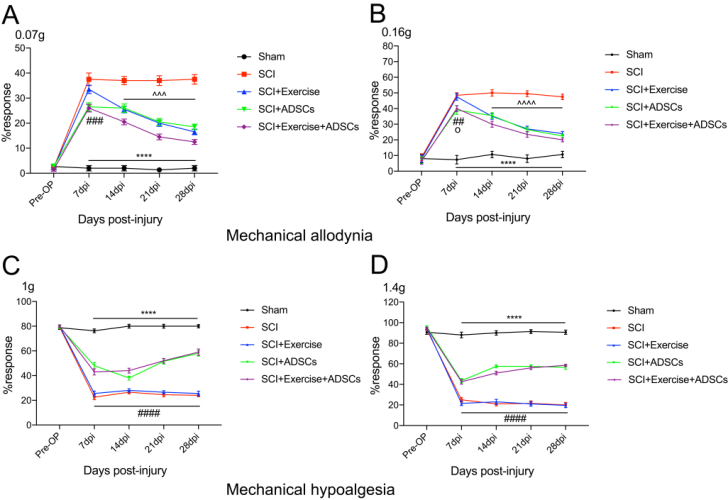
图1 脊髓损伤后第7天开始小鼠出现神经病理性疼痛,运动锻炼结合ADSCs治疗可部分缓解损伤小鼠的神经病理性疼痛 (图源:Cheng et al., Neural Regen Res, 2023)
小鼠的温觉过敏和冷痛觉减退。运动锻炼结合ADSCs治疗对小鼠脊髓损伤后神经病理性疼痛改善效果具有一定的叠加作用。同样的,有研究也发现自主锻炼可有效缓解脊髓损伤后大鼠的机械感觉过敏,而温觉异常未见明显改善[5]。在不同的神经病理性疼痛模型中,小胶质和星型胶质细胞标记物Iba1和GFAP表达增高与疼痛的发生发展密切相关[6-7],此次研究也证实T11脊髓损伤后,小鼠损伤平面以下的腰髓背角Iba1和GFAP表达显著增高,而运动锻炼结合ADSCs治疗可有效减少它们的表达(图2和图3)。同时,ADSCs治疗还可减少小鼠脊髓损伤区域大小,具有一定的神经保护作用。这些结果表明运动锻炼结合ADSCs治疗可能通过多种途径缓解小鼠脊髓损伤后神经病理性疼痛。
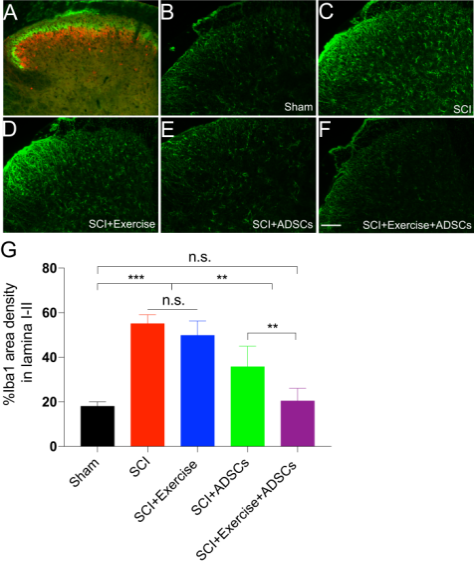
图2运动锻炼结合ADSCs治疗可减少脊髓损伤小鼠腰髓背角Iba1的表达(图源:Cheng et al., Neural Regen Res, 2023)
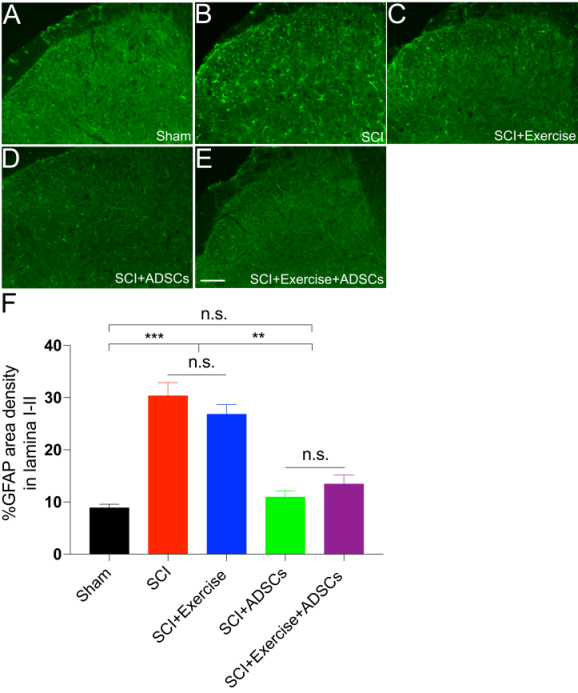
图3 运动锻炼结合ADSCs治疗可减少脊髓损伤小鼠腰髓背角GFAP的表达(图源:Cheng et al., Neural Regen Res, 2023)
总之,运动锻炼结合ADSCs治疗对小鼠脊髓损伤后神经病理性疼痛有一定的缓解作用,然而其具体机制仍不明确,作者的研究发现二者结合可能通过减少脊髓损伤区域大小,并改善损伤平面以下神经炎症微环境,从而部分缓解脊髓损伤小鼠的病理性疼痛。该研究对未来临床应用多种方式结合治疗脊髓损伤后神经病理性疼痛提供新的思路。
当然该研究也存在一定的局限性。首先该研究只是发现了运动锻炼结合ADSCs治疗改善小鼠病理性疼痛,减少损伤区域,抑制Iba1和GFAP表达的现象,并未对此现象做深入的机制研究,未来还需要进一步应用转基因小鼠、药物等多种方式来明确其分子机制。另外,该研究发现损伤平面以下腰髓背角Iba1和GFAP的表达异常,而背根神经节作为感觉传入脊髓背角的重要环节,该研究却未对Iba1和GFAP在背根神经节中的表达进行探究。最后,该研究只在实验的最后检测了Iba1和GFAP的表达,并未在脊髓损伤后小鼠神经病理性疼痛发生发展过程中取多个时间点进行检测。理想情况下,应动态检测运动锻炼结合ADSCs治疗后对Iba1和GFAP的作用变化,并动态分析它们与神经病理性疼痛的相关性。#br#
#br#
原文链接:https://doi.org/10.4103/1673-5374.361533#br#
#br#
参考文献#br#
1. Dugan EA, Schachner B, Jergova S, et al. Intensive locomotor training provides sustained alleviation of chronic spinal cord injury-associated neuropathic pain: a two-year pre-clinical study. J Neurotrauma. 2021;38(6):789-802.#br#
2. Dehdashtian A, Bratley JV, Svientek SR, et al. Autologous fat grafting for nerve regeneration and neuropathic pain: current state from bench-to-bedside. Regen Med. 2020;15(10):2209-2228.#br#
3. McFarlane K, Otto TE, Bailey WM, et al. Effect of sex on motor function, lesion size, and neuropathic pain after contusion spinal cord injury in mice. J Neurotrauma. 2020;37(18):1983-1990.#br#
4. Kishima K, Tachibana T, Yamanaka H, et al. Role of Rho-associated coiled-coil containing protein kinase in the spinal cord injury induced neuropathic pain. Spine J. 2021;21(2):343-351.#br#
5. Hutchinson KJ, Gómez-Pinilla F, Crowe MJ,et al. Three exercise paradigms differentially improve sensory recovery after spinal cord contusion in rats. Brain. 2004;127(Pt 6):1403-1414.#br#
6. Raghavendra V, Tanga F, DeLeo JA. Inhibition of microglial activation attenuates the development but not existing hypersensitivity in a rat model of neuropathy. J Pharmacol Exp Ther. 2003;306(2):624-630.#br#
7. Kawasaki Y, Xu ZZ, Wang X, et al. Distinct roles of matrix metalloproteases in the early- and late-phase development of neuropathic pain. Nat Med. 2008;14(3):331-336.
该研究获得国家自然科学基金(81971151, 82201360, 82202739);国家自然科学青年基金(82102583);广东省自然科学基金(2020A1515010306);广州市科技计划项目(202102020040);博士后国际引进项目 (YJ20210208);第71批博士后面上项目(2022M713592);广东省区域联合基金(2021A1515110188)支持。
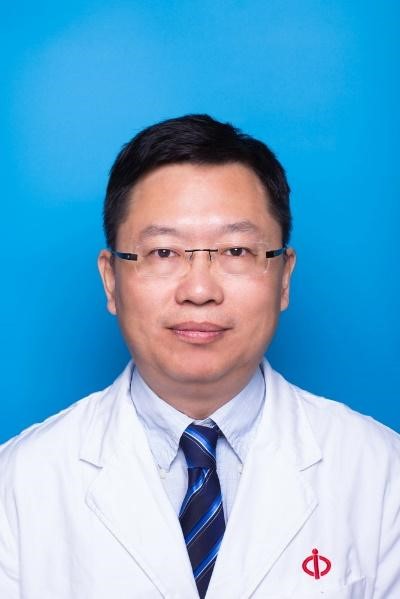
万勇,中山大学附属第一医院骨-显微医学部副主任,脊柱外科主任
从事骨科临床工作 30 余年,主要专心于脊柱外科工作,在脊髓损伤修复的细胞学研究, 及脊柱肿瘤的外科治疗方面积累了大量的临床病例和丰富的经验。主持完成国家自然科学基 金 3 项,培养博士后 1 人,博士生 1 人,硕士生 10 人,在站博士后 3 人。发表论文 30 余篇, 其中 SCI 收录杂志 10 篇,主编《脊柱截骨术》等专著 2 部。现任广东省医学会脊柱外科分会副主任委员。 社会兼职:1. 中华医学会骨科学分会微创学组 委员;2. 中国医师协会骨科医师分会脊柱外科学组 委员;3. 广东省医学会脊柱外科学分会 副主任委员;4. 广东省中西医结合学会脊柱外科分会 副主任委员;5. 广东省医学会粤港澳大湾区脊柱外科联盟 副主席;6. 广东省健康管理学会骨科学专业委员会 委员;7.中国康复医学会脊柱脊髓损伤专业委员会脊柱肿瘤学组 委员。#br#
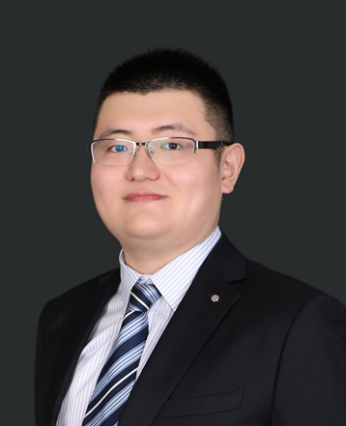
王乐,中山大学附属第一医院脊柱外科,副主任医师、医学博士、硕士研究生导师
中国康复医学会颈椎病专委会科普学组 委员
广东省医学会脊柱外科分会腰椎学组 秘书
主持国家级和省级基金多项,发表SCI和中文核心期刊论文10余篇




